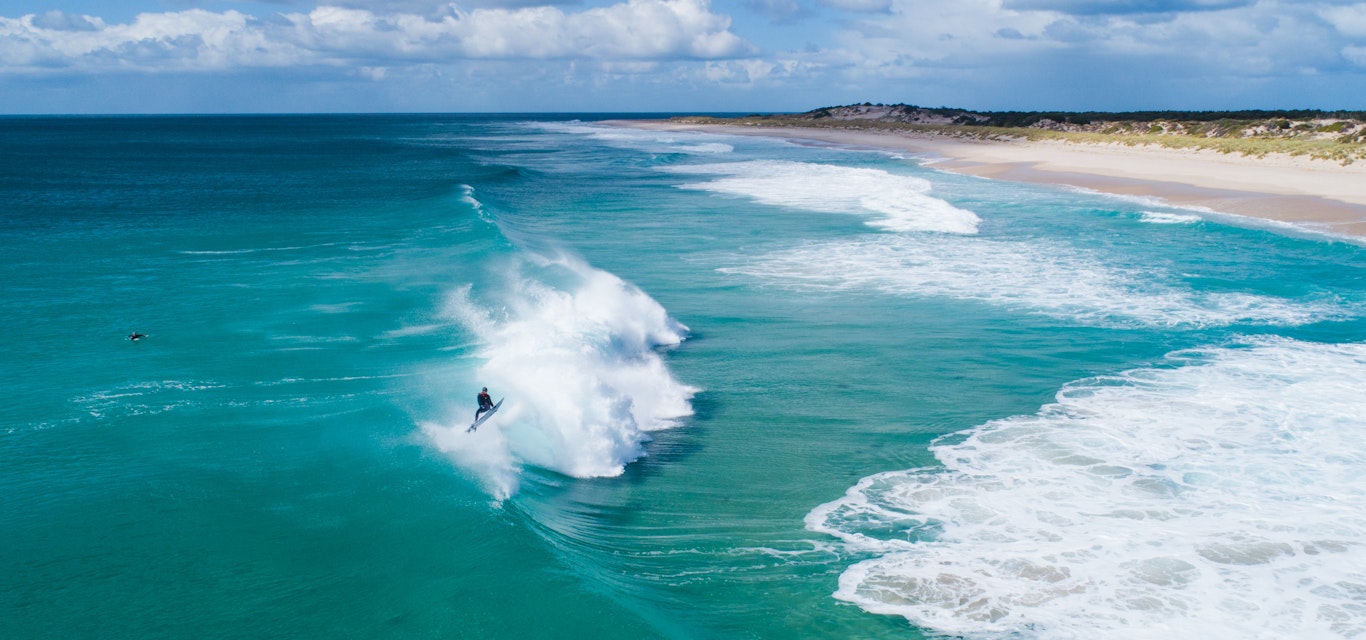Harnessing the waves
This tiny island in the Bass Strait is a leader in green energy. Andrew Bain travels to King Island to explore its eco credentials.
At Stokes Point, the wind and waves are near deafening companions. Off this southern tip of King Island, Bass Strait and the Southern Ocean meet so ferociously that, two decades ago, it was the site of the world’s first tow-in surfing competition. The only thing that rivals the ocean’s power here is the wind – the notorious roaring forties that blow in across thousands of kilometres of unbroken Southern Ocean waters, seemingly flattening the island in its path.
Standing here, among wind-pruned scrub, there’s a rawness and ruggedness that belies the gentility of King Island life – the green pastures, the laissez-faire island days, the finely crafted cheeses and meats, and a burgeoning crop of luxury accommodation properties – but all inside the brutal grip of nature.
This is an island that has witnessed more than 100 shipwrecks, including Australia’s worst peacetime maritime disaster, when the Cataraqui ran aground on a reef during a storm in 1845, killing 400 people. But instead of bowing to these forces, King Island has been busily harnessing them.
Credit: Stu Gibson
Drive south from Currie, the largest town on this island of 1600 residents, and one of the first things you pass is its wind farm, with five turbines chopping at the sky. Built in 1998, initially with three turbines, it was just the second commercial wind farm in Australia (after the Salmon Beach wind farm near Esperance, WA). Today, as part of the hybrid, off-grid King Island Renewable Energy Integration Project (KIREIP) power system, it helps produce around 50 percent of the island’s power. According to Hydro Tasmania, KIREIP can, in the right conditions, generate 100 percent of the island’s power.
Coupled with this, the island last year completed Australia’s first trial of wave energy conversion, with a wave energy converter offshore from the small town of Grassy. The 12-month trial of the 200-kilowatt converter is reported to have, in the right conditions, produced enough electricity to power 200 homes, achieving a high average conversion rate of 48 percent of a wave’s energy. And waves are something that King Island has in abundance
Credit: Andrew Wilson
Credit: Andrew Wilson and Everything Eve
Look beyond Stokes Point’s moment of surf pioneering and you’ll find Lavinia Beach high on the east coast. When south-west swells wrap around the island, the beach’s Martha Lavinia break affirms its legendary status. Surfing Life magazine once rated it among the top 10 waves on the planet, and it has, over time, lured the likes of world-champion surfers Kelly Slater, Tom Carroll and Sunny Garcia to the island.
In remarkable contrast to these waves is placid Pennys Lagoon, tucked behind Lavinia Beach’s dunes and one of only three known ‘perched lakes’ – freshwater lakes sitting higher than the water table, so they contain no groundwater and are fed by no streams (the best-known example of a perched lake is Lake McKenzie on K’gari/Fraser Island in Queensland) – on the planet.
Surfing isn’t the only sport in which the island overachieves. Sitting in the ocean like a golf green surrounded by a water hazard, King Island has suitably become one of Australia’s most desirable golf destinations. Cape Wickham Golf Links and Ocean Dunes Golf Course are considered among the country’s best golf courses – they were ranked No 3 and No 13 respectively in Australian Golf Digest’s 2022 ratings.
Credit: Stu Gibson
It isn’t just the task of belting a dimpled white ball that impresses on these courses. It’s each one’s wild coastal setting (Cape Wickham is laid out beneath Australia’s tallest lighthouse, which seems almost to stake it to ground against the ever-present winds) and, as ever on this island, the power of nature around them. I’ve taken non-golfers to see these courses and heard them declare that they’d almost take up the game just to play a round here.
The natural forces that have shaped the island are evident elsewhere as well. Follow the Shipwreck Trail and you get the sense that King Island has long been a maritime crash barrier, while the scene from Seal Rocks, atop the island’s highest cliffs, is a fierce one of wild water and rocky ramparts.
Credit: Stu Gibson
But not all here is harsh. At its core, King Island is a place of gentle scenes and delicate flavours inside a frame of rugged coastline. Its beef and cheese have long been lauded, and today there are restaurants such as Wild Harvest (Grassy) and Oleanda (Currie) that celebrate the produce that emerges from behind the island’s paperbark windbreaks and from the surrounding sea. Craft beers are pouring at King Island Brewhouse, and gin, whisky, vodka and limoncello are emerging from the stills at King Island Distillery.
And each time you return to Currie, those turbine blades are turning, drawing on nature’s power for the island’s power, and the Southern Ocean’s waves are slapping ashore, full of both menace and potential.
Credit: Stu Gibson
Credit: Adam Gibson
Must-do experiences on King Island
Calcified Forest
One of Tasmania’s 60 Great Short Walks, leading to a sand patch strewn with otherworldly limestone structures.
Seal Rocks
Just beyond the Calcified Forest, the road hits the coast above the island’s highest cliffs and a snarling Southern Ocean.
Cape Wickham
The southern hemisphere’s tallest lighthouse rising above the most beautiful and challenging golf course imaginable.
Restaurant With No Food
The island’s most colourful building hosts a suitably quirky island experience – a dining venue to which you bring your own food and drink.
King Island Dairy
Sample a half-dozen cheeses, which you can combine with a King Island Brewhouse beer or Tassie wine, in the tasting room of the dairy that put the island on the gastronomic map.
